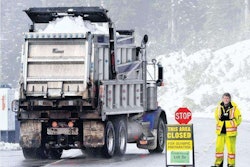 A smoke stream glides over a Navistar ProStar truck and trailer during Lawrence Livermore National Laboratory testing at the NASA Ames Center in California. (Credit Lawrence Livermore National Laboratory)
A smoke stream glides over a Navistar ProStar truck and trailer during Lawrence Livermore National Laboratory testing at the NASA Ames Center in California. (Credit Lawrence Livermore National Laboratory)MOFFETT FIELD, Calif. – When Navistar’s Steve Bruford envisions the truck of the future, he sees a tractor-trailer getting over 10 mpg.
The truck manufacturer is taking the first step toward hitting that goal through testing it’s been performing here the past 15 months in the world’s largest wind tunnel at NASA’s Ames Research Center. Under a $2 million U.S. Department of Energy grant, Navistar has been testing commercially available and proposed aerodynamic devices attached to a 53-foot trailer behind one of its ProStar tractors.
The company held a Feb. 16 press event to focus on research results, along with NASA Ames and Lawrence Livermore National Laboratory, which has been leading the testing. The project’s goal has been to increase fuel efficiency by integrating the tractor with the trailer more closely.
A bigger step is being organized by Bruford, vice president of vehicle product development at Navistar Truck Group, and his team under the DOE’s “SuperTruck” project. Navistar was awarded a $37.3 million DOE matching grant this year to develop technology and systems designed to increase heavy-duty truck fuel efficiency by 50 percent, compared with the 12 percent achieved at the facility here.

“We’re throwing the kitchen sink at it – from the engine to the tractor to the trailer – anything that can affect fuel economy,” Bruford said.
Navistar is lining up partners such as aerodynamic device maker Advanced Transit Dynamics, trailer manufacturer Wabash National, Swift Transportation, Safeway and a tire maker to work on the project and help defray Navistar’s financial share. Initial testing will begin later in the year under the five-year program.
At the Mid-America Trucking Show next month, Navistar will display a prototype of a system that will automatically move the fifth wheel to adjust the gap between the back of the truck cab and the trailer to optimize aerodynamics. Chief Engineer of Aerodynamics Ron Schoon said the “radical” system would slide the trailer back and forth to minimize airflow at highway speeds. The system, which Navistar is seeking to patent, would operate independently of the driver but react almost instantly in an emergency.
“The key is safety,” Schoon said. “We’re testing exactly how far the device can move before its locking feature engages. Depending on your configuration and how your trailer is loaded, it will always run as close to the (truck) as possible.”
Schoon said Navistar is talking with fifth wheel manufacturers about the system and perhaps partnering with a company to accelerate the product’s development. Bruford said the fifth wheel system would allow an owner-operator or fleets with thousands of trailers to use their existing equipment and still improve fuel economy through better aerodynamics. “We have a working model,” he said.
After SuperTruck’s five years, the partners aim to have a heavy-duty tractor-trailer that will achieve the 50 percent fuel efficiency improvement “by reshaping the system to be radically different, because that’s what it will take,” Schoon said. Two-fifths of that gain, or 20 percent, will come from enhanced efficiencies under the hood, and the rest from aerodynamics, tires and lighter materials, he said.
Navistar intends to leverage the DOE projects and other company research to develop a new fuel-efficient truck model in five to seven years, Bruford predicted. The company wants to take the aerodynamic ProStar “to the next level.”













